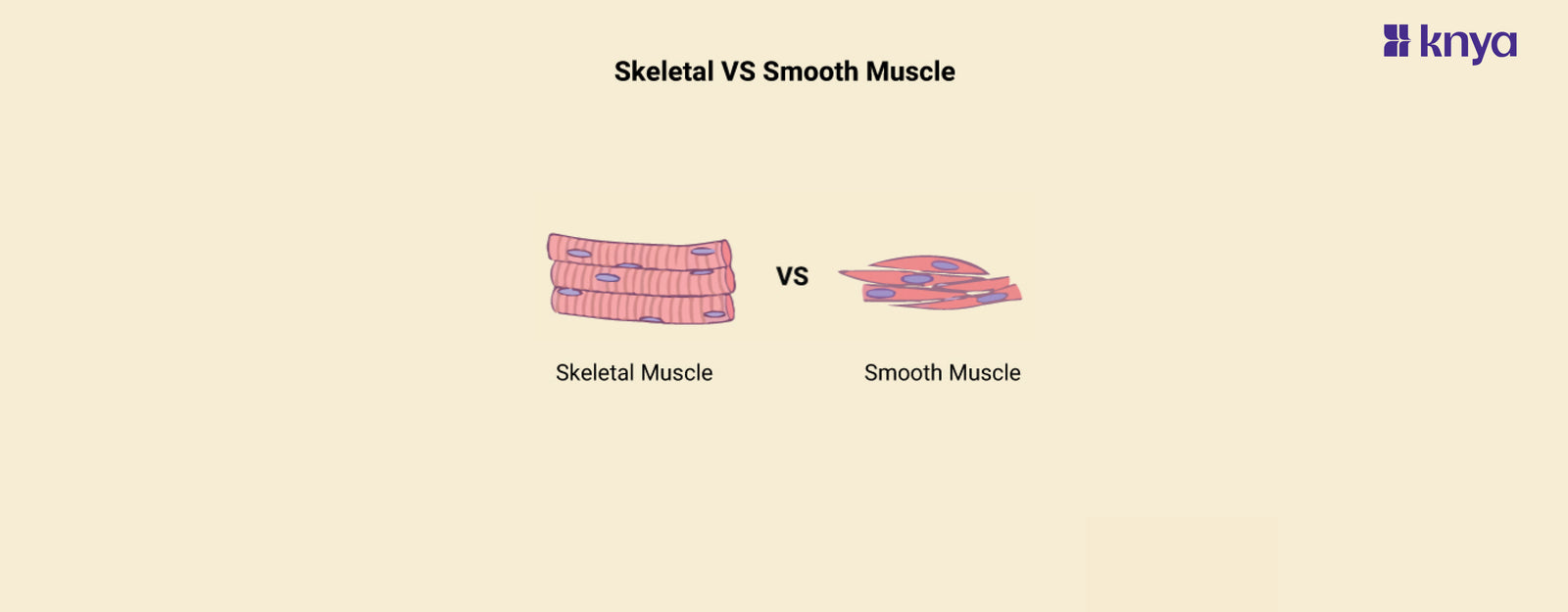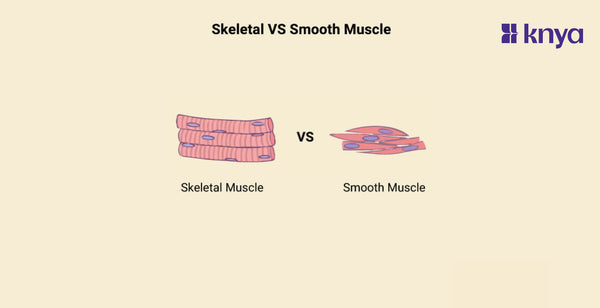Difference Between Skeletal and Smooth Muscle: Skeletal and smooth muscles are the two primary forms of muscle tissue in the human body, each with their own unique characteristics and purposes. Skeletal muscles, as the name indicates, are connected to bones and allow for voluntary movement. They are striated, which means that the regular arrangement of protein filaments gives them a striped look under a microscope. These muscles are strong, yet they exhaust fast, allowing for bursts of activity. Think about lifting weights or running. Smooth muscles, on the other hand, reside in the walls of organs such as the stomach, intestines, and blood arteries. They are non-striated and involuntary, which means we don't have conscious control over them. They work ceaselessly behind the scenes to move food through the digestive system, regulate blood pressure, and keep organs functional.
Difference Between Skeletal and Smooth Muscle
skeletal muscles are the movers and shakers, while smooth muscles are the silent workhorses of the body, each playing crucial roles in keeping us moving and functioning smoothly. Let's discuss the difference between Skeletal and Smooth Muscle.
|
Characteristic |
Skeletal Muscle |
Smooth Muscle |
|
Location |
Attached to bones by tendons, responsible for body movement |
Found in the walls of internal organs (e.g., digestive tract, blood vessels) |
|
Voluntary Control |
Voluntarily controlled |
Involuntarily controlled |
|
Striated Appearance |
Appears striated under a microscope |
Appears smooth under a microscope |
|
Multinucleated Cells |
Multinucleated cells |
Single nucleus per cell |
|
Fatigue Resistance |
Less fatigue-resistant |
More fatigue-resistant |
|
Contraction Speed |
Contracts rapidly |
Contracts more slowly |
|
Conduction of Signals |
Nerve signals travel rapidly through neuromuscular junctions |
Nerve signals travel more slowly through the autonomic nervous system |
|
Cell Shape |
Long and cylindrical |
Spindle-shaped and tapered at the ends |
|
Energy Source |
Primarily uses glycogen |
Primarily relies on aerobic metabolism |
|
Regenerative Capacity |
Limited regenerative capacity |
Higher regenerative capacity |
Browse Best Scrubs Collection
What is Skeletal Muscle?
Skeletal muscle is the tissue that controls our voluntary motions, such as walking, running, also waving hello!. It is responsible for the biceps and triceps in our arms, the quadriceps and hamstrings in our legs, and all of the muscles that enable us to move and interact with our surroundings. Skeletal muscles are striated, which means they look banded under a microscope, and are linked to bones via tendons. We consciously regulate these muscles via our neurological system.
Key Features of Skeletal Muscle:
- Skeletal muscles have a distinctive striped or "striated" appearance under the microscope due to the orderly arrangement of thick and thin muscle fibers. This arrangement allows for strong and powerful contractions.
- We can consciously control skeletal muscles, allowing us to walk, run, jump, and perform other voluntary movements. This is because they are innervated by nerves from the somatic nervous system.
- Skeletal muscles can contract quickly and forcefully, making them ideal for activities like sprinting or lifting heavy objects. They fatigue quickly, however, due to their high energy expenditure.
- Skeletal muscles are attached to bones via tendons, tough bands of connective tissue. This allows them to exert force on the bones and generate movement.
What is Smooth Muscle?
Smooth muscle, on the other hand, is involuntary, which means it is not under our conscious control. It is located in the walls of our organs, blood vessels, and airways and regulates digestion, blood pressure, and breathing. Smooth muscle cells are spindle-shaped and lack the striated look of skeletal muscle. They are governed by the autonomic nerve system, which functions independently of our conscious thinking.
Key features of Smooth Muscle:
- Unlike skeletal muscles, smooth muscles lack the striated pattern. Their fibers are arranged more randomly, giving them a smooth appearance under the microscope.
- The autonomic nervous system regulates smooth muscles, which act independently of cognitive control. They regulate activities such as digestion, blood pressure, and pupil dilation.
- Smooth muscles contract slowly and steadily, making them appropriate for long-term functions such as peristalsis (food passage through the digestive system) and maintaining blood vessel tone.
- Smooth muscle is present in many organs and tissues in the body, including the blood vessels, digestive tract, bladder, and uterus.
Shop Best Lab Coats from Here!
Similarities between Skeletal and Smooth Muscle
- Muscle Contraction: Skeletal and smooth muscles contract to produce force.
- muscular Tissue Composition: Both types of muscles are composed of muscular fibres that contain actin and myosin filaments.
- Muscle Tone: Both types of muscles have muscle tone, which is the continual, low-level contraction that keeps muscles stiff.
- Muscle Maintenance: Skeletal and smooth muscles help to maintain posture and support body functioning.
- Energy Utilisation: Both types of muscles rely on ATP as an energy source for muscular contraction.
- Nerve impulses govern the contraction of both skeletal and smooth muscles, albeit the methods vary.
While both skeletal and smooth muscle are necessary for human function, they differ significantly. Skeletal muscles, connected to bones like marionette strings, are striated powerhouses that allow for voluntary movement. They specialise in bicep curls and sprinting. Smooth muscles, which are located within organs,, on the other hand, blend in with their surroundings by seeming non-striated. They work unconsciously, silently sustaining organ processes such as digestion and blood flow, frequently for long durations. Their contractions, albeit slower and more persistent, ensure that internal activities flow smoothly. In essence, skeletal muscles are the showy performers, flexing when needed, whereas smooth muscles are the backstage crew, working ceaselessly to keep the show running.
| Check out More Articles | |
| Difference Between Psychosis and Neurosis | |
| Dorsal Vs Ventral | |
| Difference Between Striated and Unstriated Muscles | |















